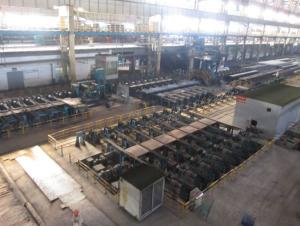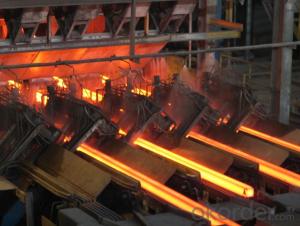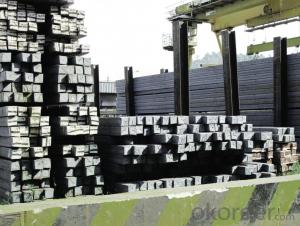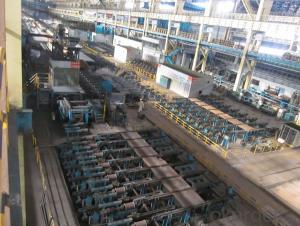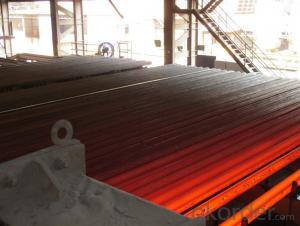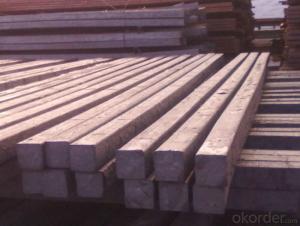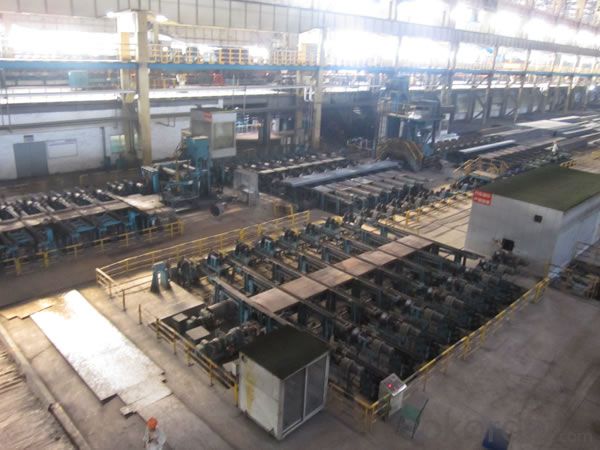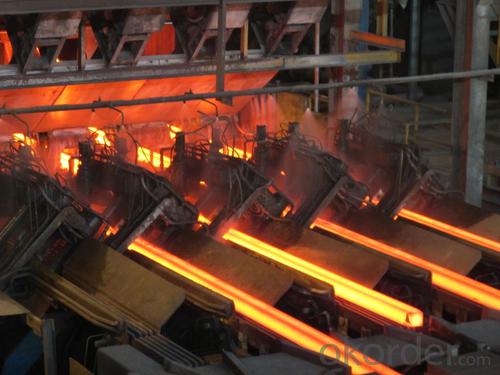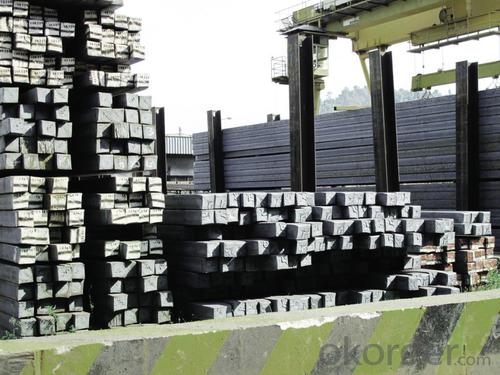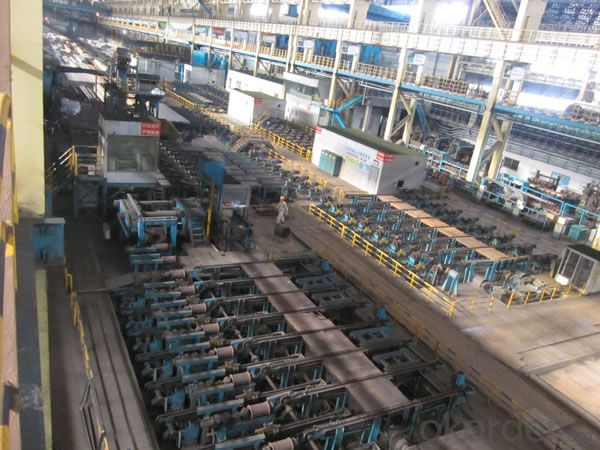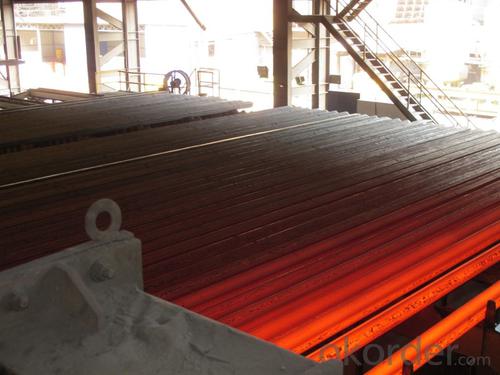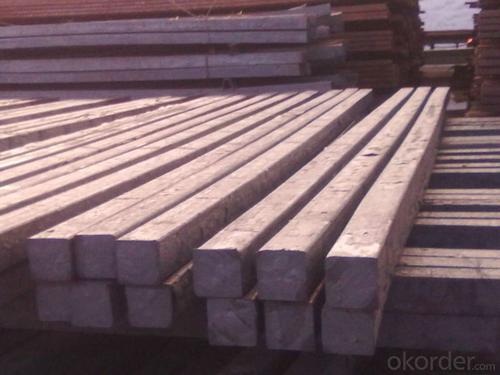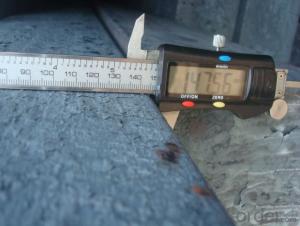Hot Rolled Square Steel Billet 3SP Standard 90mm
- Loading Port:
- Shanghai
- Payment Terms:
- TT OR LC
- Min Order Qty:
- 2000 m.t.
- Supply Capability:
- 10000 m.t./month
OKorder Service Pledge
OKorder Financial Service
You Might Also Like
Structure of Hot Rolled Square Steel Billet 3SP Standard 90mm
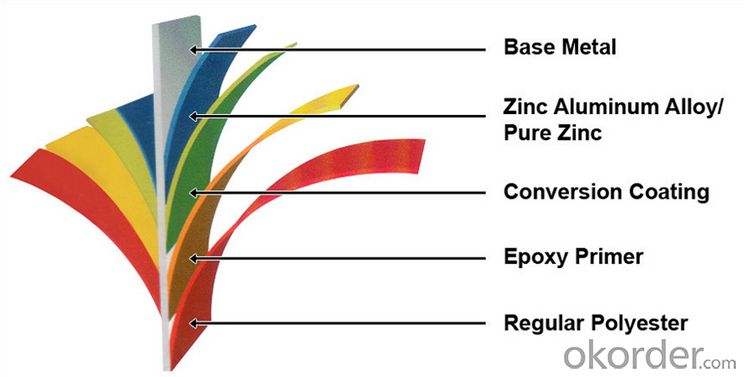
Description of Hot Rolled Square Steel Billet 3SP Standard 85mm
PPGI is made by cold rolled steel sheet and galvanized steel sheets as baseplate, through the surface pretreatment (degreasing, cleaning, chemical conversion processing), coated by the method of continuous coatings (roller coating method),
and after roasting and cooling. Zinc coating: Z60, Z80, Z100, Z120, Z180, Z275, G30, G60, G90
Alu-zinc coating: AZ60, AZ80, AZ100, AZ120, AZ180, G30, G60, G90
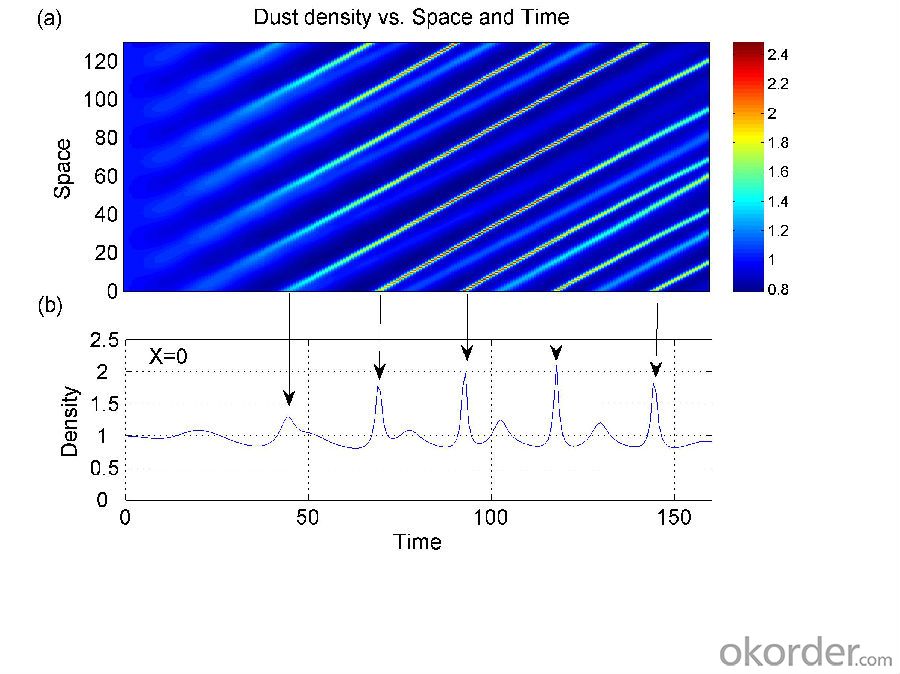
Main Feature of Hot Rolled Square Steel Billet 3SP Standard 90mm
1) Excellent corrosion resistance: The zinc layer provides a good protection of Pre-painted Galvanizeed Steel Sheet.
2) High heat resistance: The reflective surface of the material aids in efficiently reflecting the sunlight away and in turn reducing the amount of heat transmitted. The thermal reflectivity converts into energy savings.
3) Aesthetics: Pre-Painted Galvanized steel sheet is available in plethora of patterns and multiple sizes as per the requirements that given by our customers.
4) Versatility: can be used in the various areas.Standard seaworthy export packing: 3 layers of packing, inside is kraft paper, water plastic film is in the middle and outside GI steel sheet to be covered by steel strips with lock, with inner coil sleeve.
Applications of Hot Rolled Square Steel Billet 3SP Standard 90mm
1) Automotive bodies: filters, fuel tanks, etc.
2) Construction materials: roofings, welding pipes,
3) Electric and electronic appliances: computer cans, etc.
4) Steel cans: containers, etc.
5) Steel furniture: washing machines, refrigerators, microwaves, etc.
6) Drums
7) Office equipment: printer, recorders, etc.
8) Motors and transformers
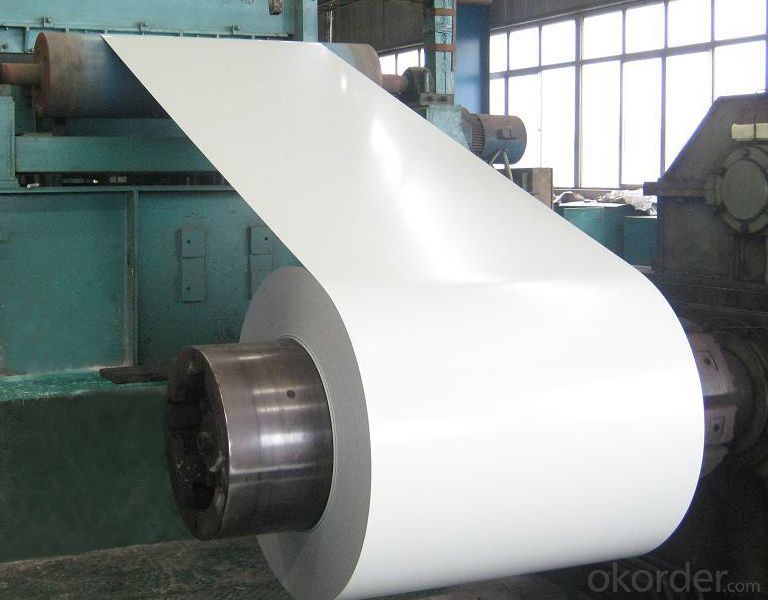
Specifications of Hot Rolled Square Steel Billet 3SP Standard 90mm
| Classified symbol | Yield Point Minimum N/mm2 | Tensile Strength Minimum | Elongation Minimum % | Application | ||||
| N/mm2 | Nominal Thickness mm (t) | |||||||
| JIS | Yogic | 0.25-0.4 | 0.4-0.6 | 0.6-1.0 | 1.0-1.6 | |||
| G3312 | specification | |||||||
| CGCC | CGCC | -205 | -270 | -20 | -21 | -24 | -24 | Commercial |
| CGCD | CGCD | --- | 270 | --- | 27 | 31 | 32 | Drawing |
| --- | CG340 | 245 | 340 | 20 | 20 | 20 | 20 | Structural |
| CGC400 | CG400 | 295 | 400 | 16 | 17 | 18 | 18 | Structural |
| CGC440 | CG440 | 335 | 440 | 14 | 15 | 16 | 18 | Structural |
| CGC490 | CG490 | 365 | 490 | 12 | 13 | 14 | 16 | Structural |
| CGC570 | CG570 | 560 | 570 | --- | --- | --- | --- | Structural |
| ASTM Designation | Yield Point Minimum | Tensile Strength Minimum | Elongation Minimum % | Application | Q/BQB 445-2004(China standard) | ASM A653/A653M | JISG 3312 | |
| ksi(MPa) | ksi(MPa) | TDC51D+Z | (CS TYPE A+Z) | CGCC | ||||
| A653(M)-99 CS TYPE A,B,C | --- | --- | --- | Commercial | TDC52D+Z | CGCD | ||
| A653(M)-99 FS | --- | --- | --- | Lock Forming | TS250GD+Z | (G250+Z) | - | |
| A653(M)-99 DS | --- | --- | --- | Drawing | TS300GS+Z | (G300+Z) | CGC 400 | |
| A653(M)-99 SS Grade33(230) | 33(230) | 45(310) | 20 | Structural | TS350GD+Z | (G350+Z) | CGC490 | |
| A653(M)-99 SS Grade37(255) | 37(255) | 52(360) | 18 | Structural | TS550GD+Z | (G550+Z) | CGC570 | |
| A653(M)-99 SS Grade40(275) | 40(275) | 55(380) | 16 | Structural | ||||
| A653(M)-99 SS Grade50(345) | 50(345) | 65(450) | 12 | Structural | ||||
| A653(M)-99 SS Grade80(550) | 80(550) | 82(570) | --- | Structural | ||||
FAQ of Hot Rolled Square Steel Billet 3SP Standard 90mm
We have organized several common questions for our clients,may help you sincerely:
1. How Can I Visit There?
Our company is located in Tianjin City, China, near Beijing. You can fly to Tianjin Airport Directly. All our clients, from home or aboard, are warmly welcome to visit us!
2. How Can I Get Some Sample?
We are honored to offer you sample.
3. Why choose CNBM?
1, ISO, BV, CE, SGS approved.
2, Competitive price and quality.
3, Efficient service team online for 24 hours.
4, Smooth production ability(50000tons/month) .
5, quick delivery and standard exporting package.
6, Flexible payment with T/T, L/C, Paypal, Kunlun bank, etc .
- Q: What are the specifications for alloy steel billets used in the aerospace industry?
- The specifications for alloy steel billets used in the aerospace industry typically include specific chemical composition requirements, such as precise percentages of various alloying elements, to ensure desired mechanical properties and performance. These billets often need to meet stringent standards for strength, durability, and resistance to fatigue and corrosion. Additionally, they may need to adhere to specific dimensional tolerances, surface finish requirements, and undergo various testing and inspection procedures to ensure their suitability for aerospace applications.
- Q: How long do steel billets last?
- The longevity of steel billets varies depending on multiple factors, including their storage conditions and utilization. Provided that they are stored appropriately in a controlled environment with low humidity and shielded from corrosion, steel billets can endure indefinitely. Conversely, if they are exposed to harsh weather, excessive moisture, or corrosive substances, their lifespan can be significantly diminished. As for their usage, steel billets are typically melted and transformed into other steel products, such as bars, rods, and beams. The lifespan of the final product hinges on its specific application and the maintenance practices implemented. Generally, steel products are renowned for their durability and longevity, rendering them a dependable option in numerous industries.
- Q: How are steel billets used in the manufacturing of oil and gas industry components?
- Steel billets are used in the manufacturing of oil and gas industry components as they serve as the starting material for various products such as pipes, valves, fittings, and flanges. These billets are heated and shaped through processes like forging, rolling, or extrusion to create the desired form and strength required for the specific component. The resulting steel components are then used in the construction and operation of oil and gas infrastructure, ensuring reliability, durability, and performance in challenging operating conditions.
- Q: Can steel billets be used in the production of electrical components?
- Yes, steel billets can be used in the production of electrical components. Steel billets can be shaped and processed into various forms such as bars, rods, or sheets, which are commonly utilized in the manufacturing of electrical components like connectors, terminals, or conductive parts. The steel's high strength, durability, and electrical conductivity make it suitable for these applications.
- Q: How are steel billets used in the manufacturing of oil and gas pipelines?
- Steel billets are an essential raw material in the manufacturing of oil and gas pipelines. They are heated and shaped into seamless or welded pipes, providing the structural strength necessary for the transportation of oil and gas over long distances. The billets undergo various processes, such as hot rolling, piercing, and elongation, to achieve the desired pipe dimensions and mechanical properties. Ultimately, steel billets serve as the foundation for the production of durable and reliable pipelines that play a crucial role in the energy industry.
- Q: What are the main factors affecting the hardenability of steel billets?
- The hardenability of steel billets, or the ability of a steel alloy to be hardened through heat treatment, is influenced by several main factors. These factors include the chemical composition of the steel, the cooling rate during quenching, and the grain size of the steel. Firstly, the chemical composition of the steel plays a crucial role in determining its hardenability. Elements such as carbon, manganese, and alloying elements like chromium, molybdenum, and nickel can significantly affect the hardenability. Higher carbon content increases the hardenability, as does the presence of certain alloying elements. These elements form carbides that enhance the formation of martensite, the hard and brittle phase that gives steel its hardness. The cooling rate during quenching is another critical factor affecting hardenability. Quenching involves rapidly cooling the heated steel billet, typically in a liquid medium such as water or oil. The cooling rate determines the transformation of the steel's microstructure. Faster cooling rates result in a higher degree of hardenability, as they promote the formation of martensite. Slower cooling rates, on the other hand, can lead to the formation of softer phases like ferrite or pearlite. Lastly, the grain size of the steel also influences its hardenability. A smaller grain size provides more nucleation sites for the formation of martensite, leading to improved hardenability. Grain refinement can be achieved through processes such as alloying, heat treatment, and controlled cooling. Additionally, the presence of non-metallic inclusions, which act as stress concentration sites, can also affect the hardenability by promoting crack initiation and propagation during quenching. In summary, the main factors affecting the hardenability of steel billets are the chemical composition of the steel, the cooling rate during quenching, and the grain size of the steel. Understanding these factors and their interplay is crucial for achieving the desired hardness and mechanical properties in steel billets during heat treatment processes.
- Q: How do steel billets contribute to the renewable energy sector?
- The renewable energy sector heavily relies on steel billets for the production of different renewable energy technologies. Wind turbines, for example, require the use of steel billets to construct their towers and foundations. These structures need to be sturdy and durable to withstand harsh environmental conditions. Additionally, steel billets are crucial in the manufacturing of solar panels. These panels are composed of photovoltaic cells that convert sunlight into electricity. Steel billets are used to create frames and mounting structures that provide support and stability to the solar panels, ensuring their proper functioning and long lifespan. Moreover, steel billets are essential in the production of hydroelectric power equipment. Hydroelectric power is generated by converting the kinetic energy of flowing or falling water into electricity. Steel billets are ideal for constructing turbine blades, shafts, and other components due to their high strength and resistance to corrosion, enabling the efficient generation of electricity from water. Furthermore, steel billets play a vital role in the manufacturing of energy storage systems, such as batteries. Since renewable energy sources like wind and solar are not consistently available, energy storage systems help store excess energy during peak times for later use. Steel billets are used in the construction of battery casings and structural components, ensuring the safety and durability of these storage systems. To sum up, steel billets are indispensable in the renewable energy sector as they provide the necessary raw material for the construction of wind turbines, solar panels, hydroelectric power equipment, and energy storage systems. Their strength, durability, and corrosion resistance make them a critical element in producing various renewable energy technologies, ultimately contributing to the acceleration of a sustainable and greener future.
- Q: Charcoal is how to
- Usually we measure the quality of charcoal mainly from the moisture content, volatile content, ash content, fixed carbon content and calorific value of charcoalTake it, thanks!!
- Q: How are steel billets used in the energy and power generation industry?
- Steel billets are an essential component in the energy and power generation industry due to their strength, durability, and versatility. These cylindrical castings of steel are used in various applications within this industry. One of the primary uses of steel billets in the energy and power generation industry is for the construction of power plants and infrastructure. Billets are commonly used to manufacture heavy-duty equipment, such as turbines, generators, and boilers, which are crucial for converting various energy sources into electricity. The high strength and resilience of steel billets ensure that these structures can withstand the harsh operational conditions and maintain their integrity over an extended period. In addition to the construction of power plants, steel billets are also used in the manufacturing of transmission and distribution systems. These systems, including power lines, transformers, and substations, require sturdy materials to support the efficient transmission and distribution of electricity. Steel billets are often used to produce the poles, towers, and other structural components that form the backbone of these systems, ensuring their reliability and long-term functionality. Moreover, steel billets find application in the production of equipment used for renewable energy generation. For instance, in wind energy, billets are used to manufacture the towers on which wind turbines are mounted. These towers must withstand the forces exerted by wind and support the weight of the turbine, and steel billets provide the necessary strength and stability for this purpose. Furthermore, steel billets are employed in the fabrication of equipment for oil and gas exploration, extraction, and refining. In this industry, billets are utilized to produce pipes, valves, and other components that are essential for transporting and processing petroleum and natural gas. The robustness of steel billets ensures the integrity and safety of these systems, even in demanding conditions such as high-pressure and high-temperature environments. In summary, steel billets play a vital role in the energy and power generation industry by serving as the building blocks for the construction of power plants, transmission systems, renewable energy infrastructure, and oil and gas facilities. Their strength, durability, and versatility make them an indispensable material for ensuring the reliability, efficiency, and safety of these critical energy systems.
- Q: What are the potential applications of steel billets in the defense sector?
- Steel billets have a range of potential applications in the defense sector, including the manufacturing of armored vehicles, tanks, and naval vessels. They can also be used for constructing military infrastructure, such as bunkers, fortifications, and barriers. Additionally, steel billets can be utilized in the production of various weapons and ammunition, such as artillery shells and components for firearms. The strength, durability, and versatility of steel make it an essential material for various defense applications.
Send your message to us
Hot Rolled Square Steel Billet 3SP Standard 90mm
- Loading Port:
- Shanghai
- Payment Terms:
- TT OR LC
- Min Order Qty:
- 2000 m.t.
- Supply Capability:
- 10000 m.t./month
OKorder Service Pledge
OKorder Financial Service
Similar products
Hot products
Hot Searches
Related keywords
